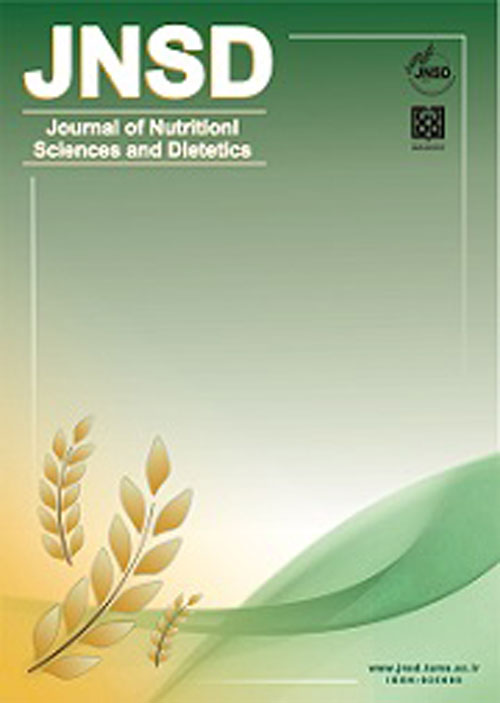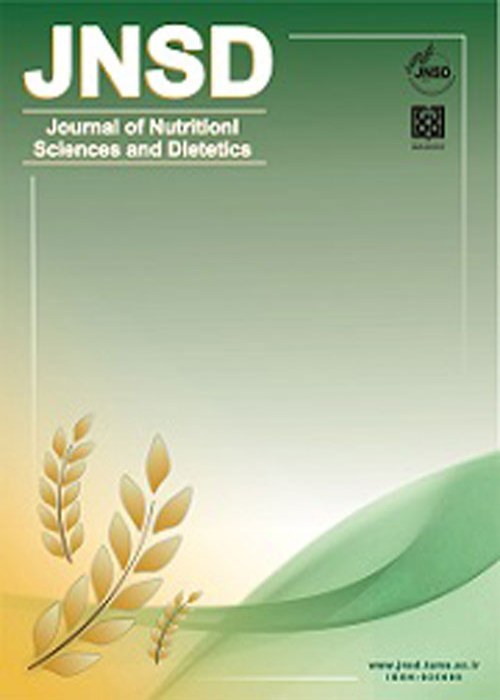فهرست مطالب

Journal of Nutritional Sciences and Dietetics
Volume:3 Issue: 3, Summer 2017
- تاریخ انتشار: 1396/09/20
- تعداد عناوین: 7
-
-
Pages 3-10Background
Nutrition might play a role in the etiology of multiple sclerosis (MS). Since dietary patterns associated with MS risk have not been well studied, this study was performed to evaluate the relationship between MS risk and major dietary patterns recognized by factor analysis in a sample of MS cases in Iran. Methods and Material: A 168-item food frequency questionnaire was used to assess the previous years dietary intake of 68 MS cases and 140 matched controls by age and sex, aged 20-60 years, who were admitted to hospital between January-March 2012. Factor analysis was used to define the major dietary patterns and the relationship between dietary patterns and risk of MS was assessed by multivariate logistic regression.
ResultsTwo major dietary patterns were identified in the study population; Healthy dietary pattern and Western dietary pattern. A significant inverse relationship was seen between dietary pattern 1 and the risk of MS (OR: 0.30, CI: 0.09-0.47, P value
ConclusionThe results shown that following a Healthy dietary pattern was related to a reduced risk of MS and following a Western dietary pattern was marginally related to an increased MS risk, but further research is needed to establish a causal relationship between them.
Keywords: Multiple Sclerosis, Dietary Pattern, Factor Analysis -
Pages 11-17BackgroundDiet plays substantial role in the metabolism of many biochemical kidney stone risk factorsObjectiveTo evaluate the association of major dietary patterns with risk factors of kidney stone formation among Iranian men.MethodsThis cross-sectional study conducted on 264 adult men (19-89 years). The usual dietary intake of individuals over 1 year was collected using a validated semi-quantitative food frequency questionnaire. Anthropometric measurements were made and 24-h urine sample was collected. Adjusted binary logistic regressions were conducted to evaluate the associations.ResultsThe three major dietary patterns identified by factor analysis were healthy, unhealthy and spice-caffeine dietary patterns. After adjustment for potential confounders (age, BMI and energy intake), the odds ratio of hypocitraturia in the second (OR=0.57, CI=0.24-1.39) and third (OR=0.24, CI=0.10-0.56) tertiles and the hypercalciuria in the second (OR= 0.38, CI=0.17-0.87) and third (OR=0.20, CI=0.10-0.46) tertiles of healthy pattern was decreased compared to first tertile. The hypocitraturia in the second (OR=1.14, CI=0.56-2.32) and third (OR=5.14 CI=2.04-12.96) tertiles, the hypercalciuria in the second (OR=0.67, CI=0.35-1.36) and third (OR=4.11, CI=1.77-9.56) tertiles of unhealthy pattern were increased compared to the first tertile. There was no significant relationship between healthy and unhealthy dietary patterns with creatinine, oxalate and uric acid (P>0.05).ConclusionA higher adherence of the Unhealthy and spice-caffeine dietary patterns, and lower adherence of the Healthy dietary pattern, increases the risk of kidney stone formation in men.Keywords: dietary patterns, kidney stone, urine sample, food frequency questionnaire, logistic regression
-
Pages 18-22Background
Several studies have evaluated the effect of riboflavin supplementation on migraine attack with conflicting results. To estimate the conformity of the data on the topic, we accomplished a systematic review and meta-analysis of the available randomized clinical trials studies. To evaluate the effects of Riboflavin supplementation on frequency and duration of migraine attack.
MethodsA systematic research of randomized controlled trials has been conducted on Medline and EMBASE through PubMed, Scopus, and Google Scholar that was completed by a manual review of the literature up to December 2017. Pooled effect estimated by using random-effect model and heterogeneity was assessed by Cochrans Q and I2 tests.
ResultsOf 411 articles finally 5 RCTs were met inclusion criteria. The results of this meta-analysis showed that the WMD of migraine attack duration from baseline was -11.58 hr. (95% confidence interval = -15.93 to -7.22, p
ConclusionThis meta-analysis confirmed that riboflavin supplementation has beneficial effects in relieving migraine attacks as adjunctive therapies and it can reduce the frequency and duration of migraine but additional RCTs in which enough randomization methods are used for evaluating the effects of riboflavin supplementation on migraine attacks are warranted.
Keywords: migraine, riboflavin supplementation, randomized controlled trials -
Pages 18-22Background
Type 2 diabetes is a group of heterogeneous disorders characterized by various degrees of insulin resistance, impaired insulin secretion, and increased glucose production. Sugar substitute are known as a food additive that provides a sweet taste like sugar without excess energy. Some sugar substitutes are naturally produced, and others are synthesized. Those resources which are not natural are generally called artificial sweeteners.
ObjectiveThe present study was carried out to assess the effects of artificial sweeteners in diabetic patients by considering the level of blood sugar before and after intervention.
MethodsA total of 30 patients were included in this clinical trial. The patients were asked not to use the artificial sweeteners for 3 months and then were asked to consume diabetic especial diet containing artificial sweeteners such as sugar, biscuit and candy under the supervision of food specialist for the next three months.
ResultsThe average Fasting blood glucose of diabetic patients increased from (121.03±25.3 mg/dl) to (152 ± 42 mg/dl) at the end of second trimester. Also, two hours postprandial glucose test showed a significant increase from (164.4±44.4 mg/dL) to (222±72 mg/dL). Interestingly, the average of HbA1C levels increased since (6.89 ± 0.9%) to (7.40 ±1.2%) at the end of second trimesters.
ConclusionThe results indicated that consuming food gradients containing artificial sweeteners may increase blood sugar in diabetic patients.
Keywords: type 2 Diabetes_fasting blood glucose_2 hour post prandial_blood glucose_Hb A1C_Artificial sweeteners -
Pages 19-25
Background/
ObjectiveThis study was performed to determine the association between consumption of low-fat, high-protein diet and odds of GERD in a large group of Iranian population.
Subjects andMethodsThis cross-sectional study was done on 3362 subjects. We used a validated, self-administered, dish-based semi-quantitative food frequency questionnaire (FFQ) with multiple choice frequency response categories for assessing usual dietary intakes. Dietary fat and protein intakes were obtained from the FFQ. To examine the adherence to a low-fat, high protein diet, participants were divided based on median intake of these macronutrients. We defined GERD as the presence of heartburn sometimes, often or always during the three months prior to the study.
ResultsDietary fat intake was not significantly associated with GERD, even after further controlling for confounding factors including BMI (Odds ratio for comparing highest vs. lowest quartiles of fat intake: 1.11; 95% CI: 0.96-1.78). The same findings were also reached for protein intakes; such that those with the highest protein intakes had not significantly reduced odds for GERD, either before (0.83; 0.67-1.04) or after adjustment for potential confounders (0.97; 0.56-1.67) including BMI (0.84; 0.48-1.47). Adherence to a low-fat, high protein diet was not significantly associated with the odds of GERD, even after adjustment for potential confounders, including diet-related variables.
ConclusionIn conclusion, in this large-scale cross-sectional study among Iranian adult population, we failed to find any significant association between adherence to a low-fat high-protein diet and odds of GERD. It seems that in order to achieve a comprehensive result; more studies are needed with different design.
Keywords: low fat, high protein diet, Reflux, Isfahani Adults -
Pages 31-34
Development of instruments to measure habitual dietary intake in large epidemiological studies has been investigated extensively. A 168-item Food Frequency Questionnaire (FFQ), originally developed for Tehran Lipid and Glucose Study (TLGS), is used widely in Iranian food and nutrition studies. In addition to measurement errors at data recording and entry, the printed form is time consuming and costly, both financially and environmentally. This technical report develops a Computer Assisted Personal Interview (CAPI) program to collect food and nutrition data using the Iranian 168-item FFQ. The U.S. Census Bureaus CSPro software is used to construct the CAPI application. The application runs on Android phones, tablets, and computers with Microsoft Windows operating systems (OS). The language of the CAPI is Farsi. This easy to use CAPI attempts to reduce time, cost, and human error in nutrition research at national and subnational level.
Keywords: Food Frequency Questionnaire, Computer Assisted Personal Interview, Food, Nutrition Survey, Iran


